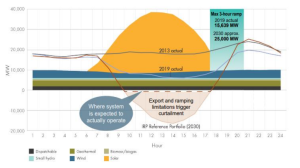Properly Pricing for Progress: How we can overhaul electricity tariffs to efficiently integrate distributed energy resources into the grid
Dr. Beia Spiller is a Fellow and Transportation Program Director at Resources for the Future. She had previously served as a Lead Senior Economist at EDF.
This post is the final in a series dedicated to the future of the electricity sector and new scholarship supported by the Alfred P. Sloan Foundation. Each post is based on a discussion between select researchers and experts working on relevant policy. To learn more, visit the series website.

As a growing number of distributed energy resources (DERs)–from rooftop solar panels to batteries–make up a greater share of the nation’s electric grid, electricity providers, policymakers and academics are recognizing that most electricity tariffs do not value or compensate for them effectively.
In the most recent and final webinar, I joined three other panelists and discussed why the current pricing system doesn’t work and, more importantly, explored ways regulators and utilities can reimagine electricity tariff structures to better price DERs and encourage more efficient electricity use. Dr. David Brown, Associate Professor at the University of Alberta’s Department of Economics moderated the panel, which included Dr. Michael Caramanis, Boston University Professor of Mechanical and Systems Engineering, Dr. Burçin Ünel, the Energy Policy Director at the Institute for Policy Integrity at New York University School of Law, and Paul Phillips, an expert in California energy policy now overseeing the Retail Rates group in the California Public Utility Commission’s Energy Division.
Misaligned system
Perhaps the biggest challenge facing DER integration is pricing, which in its existing form is both unclear to many retail ratepayers and does not always encourage efficiency given that it does not accurately reflect underlying costs.
If prices were cost reflective, this could incentivize households to make decisions around DER operation and use that align with reducing underlying costs. However, most residential tariffs are not. For example, even though the cost of electricity varies across the hours of the day, most individuals pay flat, volumetric rates that don’t vary over the time of day; this means households have no incentive to reduce demand during high-cost hours, leading to higher costs for everyone.
Furthermore, consumers are not charged for their contribution to capacity costs, meaning they have little incentive to reduce their maximum demands. Finally, because many flat volumetric rates bundle in fixed costs, they artificially inflate them, distorting incentives related to both consumption (making it more costly than necessary to consume) and generation (meaning we pay more for distributed solar than we should).
Another problem plaguing the current system: asymmetric information. Dr. Ünel’s research examines the role of information problems, which are not typically taken into account in the engineering and economic models that inform policy discussion. While these types of problems vary across the United States, they largely relate to distribution network and consumer demand data. Most consumer demand data remains closely held by utilities. Interconnection information is also lacking, meaning both developers and end-use customers do not know if they can connect a new DER to the grid at a particular location.
The combination of imperfect foresight and information asymmetry about hosting capacity or consumer demand reduces social welfare, as it hinders widespread adoption of DERs. However, Ünel and co-authors find a role for more granular compensation mechanisms than net energy metering to alleviate some of these welfare impacts.
California’s challenges on DERs and pricing
One part of the country actively thinking about these issues is California, which is aggressively integrating DERs into its system as it moves toward electrification and decarbonization.
The California PUC’s Phillips outlined a number of the state’s challenges, including reliability and rapidly rising retail rates, due in part to wildfire expenditures. In California, where the rate of inflation is rising faster than in other parts of the country, Phillips noted, “We need to move forward with great caution in terms of how we manage our retail rates and our rate design.”
Another significant challenge for the state as it integrates more renewables into the grid: the infamous “duck curve.” This refers to the graph illustrating the timing imbalance between peak demand and the production of renewable energy. As greater amounts of renewable energy increase over time, this problematic spike in afternoon/evening peak demand could be alleviated at least in part by smart pricing and demand response programs. However, Phillips noted that these are generally uncoordinated, and the issue remains unresolved.

A variety of potential solutions
The panelists each outlined a series of proposed solutions to the challenges facing DER integration. I provided an overview of my research into DER adoption within the Commonwealth Edison territory in parts of Chicago. We found that allowing the volumetric rate to be time variant (whether by time of day or in real time) led to greater adoption of rooftop solar panels, as the high-cost hours aligned with the sunshine hours, increasing compensation for grid exports. However, we also found that moving away from purely volumetric-based tariffs to make the tariffs more cost-reflective reduces the incentive to invest in generation DERs but increases the incentive to invest in beneficial electrification (such as electric heat pumps). Therefore, depending on policymakers’ ultimate goals, optimal pricing structure will differ.
Both Dr. Caramanis and Dr. Ünel’s research demonstrated a benefit from implementing distribution locational marginal pricing (or dLMPs), a type of electricity tariff that varies not just over time but over location (factoring in costs associated with consumption at the hyper local distribution level). By structuring the tariff in this way, dLMPs most accurately price consumption and compensate generation from DERs given their underlying capacity, energy value or underlying environmental value.
Dr. Caramanis discussed how dLMPs can correctly price the three Rs (real power, reactive power and reserves for reliability), thereby allowing utilities to more accurately calculate marginal prices of consumption across location and hour of the day, resulting in more efficient compensation for DER owners. Under dLMPs, he finds that not only are total costs lower, but compensation for DER owners is higher, compared to other forms of pricing that are less cost reflective. This is even true for households that are less able to adapt to significant variation in costs, as the households that can adapt would reduce costs for everyone.
He further outlined a potential platform market structure based on dLMP pricing that allows the utility to share information and coordinate across DERs, generation and flexible demand. “Pricing for those three Rs allows us to efficiently and economically put together and coordinate everybody who is connected into a network–and also have coordination across networks.”
Similarly, Dr. Ünel found that implementing dLMPs as the underlying tariff for compensating DERs provides significant welfare gains that can overcome the welfare losses due to information asymmetries. Because dLMPs are cost-reflective, they lead to optimal DER adoption in parts of the grid where the benefits are largest. Thus, any decline of social welfare from information asymmetries would be offset by extraordinarily high gains in efficiency from optimal DER placement. Even a tariff that can coarsely resemble dLMPs, such as Value Stack compensations, would have social welfare benefits.
Real world applications
Though Drs. Caramanis and Ünel’s findings were within an academic research context, Phillips presented that California is moving in the direction suggested by the researchers through the adoption of a unified framework around electricity pricing. This framework would encourage comprehensive pricing reforms by eliminating outdated rate design elements, promoting more dynamic, time-differentiated pricing, and capturing locational values that facilitate a transition to an increasingly bidirectional, transactive grid.
To transition to this new system, Phillips outlined a series of steps, described in detail in a new whitepaper produced by his team at the Commission. First, the state would develop standardized universal access to current electricity prices. It would then introduce dynamic prices based on real-time wholesale energy costs on an opt-in basis. Consumers could also opt into a system that allowed them to pay modified prices based on real-time, localized grid conditions (as in the dLMPs discussed by the researchers). The state would then be able to transition to a bi-directional price. Finally, consumers could enroll in a subscription rate based on average load shapes and energy quantities or even lock in prices in advance.
Phillips acknowledged the PUC continues to confront some barriers, including existing technology limitations. He and his colleagues are also concerned about whether the pricing scheme is too dynamic and are not yet certain how to address any potential revenue shortfalls. However, the PUC will introduce consumer protection measures and engage in a robust marketing campaign to evaluate how its pilots are working and determine what kind of tariffs it could introduce in the future.
A call for stakeholder engagement
Overhauls to market design will unleash a series of major changes for both operators and ratepayers. Both Dr. Ünel and I argued that researchers should work with different stakeholders to better understand their concerns, especially as they relate to energy justice and energy burdens.
Starting with incremental changes—like time-of-use rates prior to implementing real time prices—can allow people to gradually become more price responsive. Then, utilities could increase rate complexity while incorporating additional innovations like automated technologies, allowing households to be even more price responsive. But it’s important that households and stakeholders understand the benefits of moving towards more cost-reflective pricing to reduce system costs, improve environmental benefits, and reduce household electric bills. With a shared vision of how we can improve outcomes, and a clear understanding of the process needed to achieve that future (including consumer protections), these proposed tariff changes have a greater chance of becoming our new reality.











